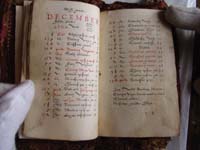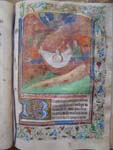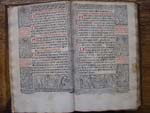Books of Hours
- Prayer Books for a Broad Spectrum of Society
In the later Middle Ages, the laity used Books of Hours, books with prayers for specific times of the day. These devotions were prefaced by a calendar marking the important feast days that varied with location, for example those of Rome were slightly different from those of England. The books invariably included the penitential psalms, the Mass for the dead and commemoration of souls, and a section called the psalter of St. Jerome. With the English break with Rome, a new set of regulations governed the prayer books. Medieval books were defaced in order to conform to injunctions against depiction of God, saints, and reference to Thomas Becket, Bishop of Canterbury and papal supremacy.
Fifteenth-century lavishly illustrated manuscripts
Book of Hours of the Virgin Mary MS 35 1425-1450 defaced, on the left. The soul being brought to heaven (as a half figure in a sheet on the left) is untouched but the two angels and the image of God have been defaced.
Book of Hours - belonging to Cardinal Thomas Wolsey (Cardinal and Lord Chancellor) MS 57, on the right. The book was not defaced because it was taken to Continent and returned when Catholics could once more worship openly.
Book of Hours of Mary Queen of Scots, below right, carries text only. This is a small personal book which is believed have been in her possession while she stood on the scaffold at Fotheringay for her beheading. The December calendar shows in red December 25 Nativitae Domini (the birth of the Lord) and in black Dec. 29 Thome epis. et m. (Thomas Becket, bishop and martyr).
 See
English and imported Books of Hours in the Huntington Library: England,
written ca. 1405 and Bruges,
made ca. 1450 for English export
See
English and imported Books of Hours in the Huntington Library: England,
written ca. 1405 and Bruges,
made ca. 1450 for English export
Printed books of hours from the early 16th-century
These books were less costly since they were printed on paper in multiple examples. An international trade allowed books from France or the Low Countries to be edited to conform to English devotions. This was called Sarum Usage: Sarum is an older form of Salisbury.
Book of Hours, printed in Paris, 1512: contains English directions such as "for frendes in syknes or in necessite" or "for thy frende that is deed" before the Latin prayers.
Book of Hours, on the right, printed London, 1526. The December calendar, appropriately ends with the Last Rites (Extreme Unction) being administered by a priest to a dying man. Here, however, Tudor censors have intervened to strike the name of Thomas Becket on December XXIX (29), as well as other interventions.
See Printed
leaf, Paris, 1526 Sarum Usage, Keio University Library


